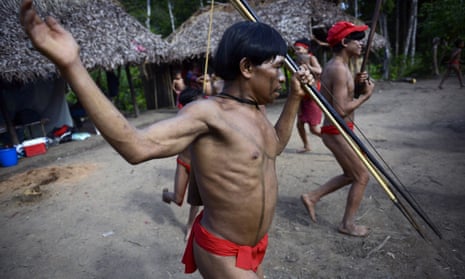An outbreak of measles that has infected nearly 500 people in northern Brazil could prove catastrophic for indigenous Yanomami people in remote areas along the Venezuelan border who are not protected from the disease, according to the not-for-profit group Survival International, which warned that hundreds could be killed if emergency action was not taken.
“This disease is a potentially devastating one,” said Jonathan Mazower, Survival International’s communications director. “It is extremely likely that people will die unless medical care is provided urgently and it is very likely that people in the forest have already died.”
The World Health Organization declared the Americas free of measles in 2016, but outbreaks can still occur when the disease is imported by visitors.
The Brazilian government has blamed the outbreak on Venezuelan refugees but health experts said that a reduction in vaccination cover was also a factor.
According to the Brazilian government, the border state of Roraima, where the Yanomami people live, has confirmed 200 cases of measles and another 177 are being investigated. The neighbouring state of Amazonas has confirmed 263 cases of measles and is investigating another 1,368. Three other states – Rio Grande do Sul, Rondônia and Mato Grosso – have also confirmed cases.
The Venezuelan not-for-profit group Wataniba, which works with Yanomami indigenous people, said it had been approached by tribespeople concerned about the measles outbreak in communities on both sides of the border. “The alarm is great because of the epidemiological vulnerability of these people to this disease,” the group said on its website.
Around 35,000 Yanomami indigenous people live on both sides of the border, according to Survival International, with many in remote communities. An estimated three groups live isolated in the forest, and in 2016 Survival published new photographs of a village home to an uncontacted group.
In the 1960s, a measles outbreak among the Yanomami killed 9% of those infected, Mazower noted, and Yanomami communities on both sides of the border are suffering from the incursion of gold miners, who could transmit the disease.
“There really needs to be very urgent medical care sent to this area,” he said.
TV Globo in Roraima reported this week that 82 suspected measles cases had been reported this year among Yanomami people, compared with none last year.
Tânia Chaves, a professor of infectious diseases at the Federal University of Pará, said she believed Venezuelan refugees had brought the disease in but a fall in vaccine cover had helped its spread. According to the Folha de S Paulo newspaper, coverage of the triple vaccine, which includes measles, has fallen from nearly 100% in 2002 to 84%.
“The cover is not ideal. This creates bubbles of susceptible people and that is where the virus enters,” Chaves said. “All of us are very concerned.”
